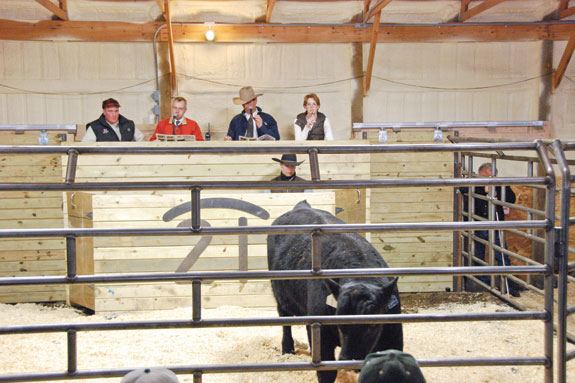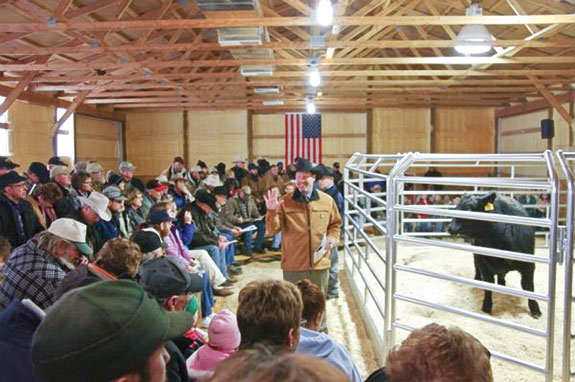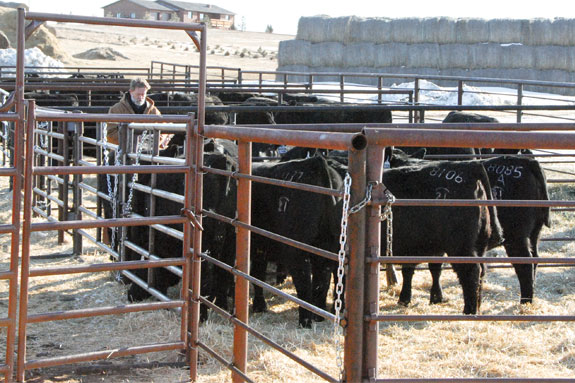One major consideration when hosting a sale is where the sale will be hosted. Will it be at the ranch or at a local sale barn? Individual operations have several options to investigate when finding a successful solution.
If you are a seedstock operator considering the start of an annual sale or making a change to an existing one, several factors are worth studying.
Do you have a barn and area that will work as a place to host the sale at your ranch?
Understand that whether you are converting a barn or building a brand-new sale facility, it can be a serious financial undertaking.
Marc Wolf of 21 Angus in New England, North Dakota, and his family just recently transitioned their Angus operation from a private treaty sale to a production sale held the last Saturday of January.

To do so, they converted an existing 40-by-112-foot pole barn they traditionally use for calving and a nearby shop into a heated sale facility. “We wanted to host at the ranch, but wanted the barn to be something we can continue to use 365 days a year,” said Wolf. Using free-standing panels, they easily created display pens in which to show the cattle. He added that the money they would have spent at a local auction barn on commission is then used in repairs or additions to their sale barn each year.
If cost is a large concern in providing an adequate sale ring, renting the local auction barn is a possibility. Craig Vejraska owns the Okanogan Livestock Market in Okanogan, Washington, and also operates Sunny Okanogan Angus Ranch with his two sons.
He said for many producers it makes sense to bring the cattle to town and utilize the auction barn’s facilities. “Everything needed for a sale is there. From the ring to the working pens out back, cattle will flow easily through an established sale barn and you can keep the momentum and that is what you want, to keep a sale’s momentum.”
Do you have quality help to work sale day at your ranch?
A benefit of selling at a local auction barn is knowing the crew handling the cattle have experience.
“When the auctioneer calls for the next bull and the door opens, there should be a bull there waiting,” said Vejraska. “At a good auction barn, you will have skilled labor. At a ranch sale you might have less experienced help, which again affects the momentum of the sale.”

How does the cost of hauling cattle to town and possibly having shrinkage or illness influence your bottomline?
Vejraska said this is a valid concern and if the ranch is located in a remote area and several miles away from a local auction, it may make sense to build a sale facility at the ranch.
For this reason, Wolf likes selling at his ranch because it ensures the cattle are kept on their same diet. In the case of a weather delay, his cattle stay in their home environment, which lessens stress factors and cause for sickness.
Since 21 Angus also winters the bulls for customers until the cattle have their breeding soundness exams in March, it cuts down on the number of trips they make to and from the auction barn with the cattle. This cuts the fuel bill and animal stress levels even further.
Is there enough time for customers on sale day?
This may be one area in which the local auction barn outshines the ranch sale. Those who host sales at their ranch ultimately spend more time lining out crews and doing more behind-the-scenes work than they would like. That time is an opportunity lost to be speaking with potential buyers.
“I will admit, since we went from a private treaty sale to a production sale at the ranch I do not have the time to talk to the customers like before,” said Wolf. “But we make that up when we deliver the bulls for free and I can spending time visiting then.”

How does the location of the sale bring value to your net profit?
Both Wolf and Vejraska bring up interesting points to ponder with this question. Wolf said his pride for his family’s ranch greatly influenced why they chose to sell there. “I think it is important for people to see where the cattle are raised or the working conditions at the ranch,” said Wolf. “I like to have people come and visit our operation.”
Vejraska suggested people’s familiarity of an auction market can be beneficial to a sale. He said people are accustomed to naturally going to the sale barn to watch cattle sell and spend a day in town.
Technology advances in many of the nation’s sale barns are also a plus. Some auction barns are equipped with Internet or video access to broadcast a production sale. “Internet can open up a new venue for cattle producers to sell to and it may not be cost effective to broadcast from your ranch,” said Vejraska.
At the end of your sale day, you should be able to positively say your sale location and facility added value to your seedstock lineup. If you can’t say this, it may be cause for change. ![]()
Photos courtesy 21 Angus
PHOTOS
TOP: Marc and Anne Wolf of 21 Angus in New England, North Dakota, just recently started hosting production sales at their ranch.
MIDDLE TOP:21 Angus converted a pole barn they use for calving and a shop into a heated sale facility to host the ranch’s January sale.
MIDDLE BOTTOM: To host your own sale at the ranch you will need to make sure you have adequate space to set up display pens.
BOTTOM: A sale at the ranch requires you to bring in our own sale day labor to work the cattle through the ring and load them out after the sale.








